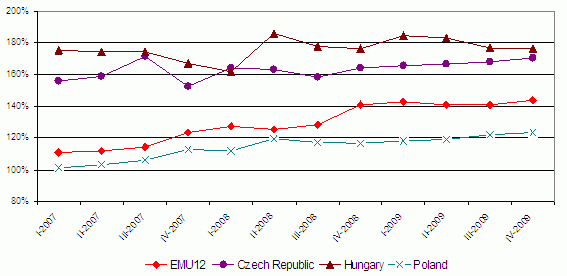A view shared by many has gradually emerged during the crisis, that a world with relatively small domestic banks is safer than one where large global institutions are also important players. This is understandable, given that many of the financial firms that had to be bailed out or supported with public funds in 2008 and 2009 in Europe and in the US were multinational banks and that the size and the scope of the activities of these banks have partly been at the root of the systemic nature of the financial turmoil (see for example Gros and Micossi 2008).
But this would be a superficial view of the current events. Institutions with regional or national frameworks of action also had to be supported because of bad investment policies. Examples include Nothern Rock in Britain and WestLB in Germany. Moreover, the key “raison d’être” of multinational banks – i.e. being able to mobilise funds across countries – could in principle be extremely useful to support global operations in times of distress and not necessarily be a cause of instability.
Multinational vs. domestic banks
An essential step to see if this view has ground is analysing how multinational banks have been faring in the months of the crisis, in comparison to domestic banks. Given the key role of these multinational banks in supporting the real economy, whether their subsidiaries in host countries have been restraining the amount of resources provided to local residents during the recession.
In a recent paper prepared for the Economic Policy panel in Madrid (Barba Navaretti et al. 2010), we provide both aggregate and micro evidence that multinational banks have actually contributed to the stabilisation of financial markets in Europe and to the provision of credit to the real economy (notwithstanding the systemic nature of the crisis).
The aggregate banking statistics of the Bank for International Settlements show that the total local claims held by the affiliates (branches and subsidiaries) of multinational banks in host countries in Europe have been stable and even increasing between the beginning of 2007 and the third term of 2009, both in absolute terms and normalised by GDP or total financial activities (Figure 1 for total local claims in local currency). Claims have been rising also in the major Central and Eastern European Countries where foreign banks account for the dominant share of total banking activities. This pattern is consistent with broader worldwide evidence.
Figure 1. Total local claims in national currencies EMU12 and specific countries
This can partly be the outcome of internal capital markets, through which multinational banks can isolate local lending from local fund raising. Moreover, in times of stress when local resources become scarce, these internal capital markets can still support local credit. In fact, the ratio between aggregate local claims and local deposits of foreign affiliates has been rising in the Eurozone countries, and also in most of central and eastern Europe (Figure 2).
Figure 2. Ration of total claims over total liabilities in local currency
Source: BIS Statistics. Note: Local Claims refer to the claims of foreign affiliates (branches and subsidiaries) on the residents of the host country (ie country of residence of affiliates)
But how does this pattern compare with the one of domestic banks? If we use micro data for up to 2008 from Bankscope and we compare foreign subsidiaries (in this case we have no information on branches) to standing alone domestic institutions we still find that during the crisis (2007 and 2008) the ratio between local loans and deposits increased and was larger for multinational banks, especially in central and eastern Europe. This is in contrast with findings by Popov and Udell (2010) and Cetorelli and Goldberg (2010).
Our empirical analysis also shows that in normal times (before 2007), multinational banks were able to use the internal capital markets to isolate local lending from the availability of local funds. In fact, the correlation of the rate of growth of local loans and deposits is lower for foreign subsidiaries of multinational banks than for standing alone domestic banks.
What is the logic behind this behaviour?
Through internal capital markets parent companies are able to channel funds towards their subsidiaries in distress. They can also do so during systemic crises, especially if internal capital markets are powerful tools to overcome market failures like asymmetric information (that we know tend to completely freeze “external” capital markets during a systemic crisis) and allocate resources more efficiently.
Of course, this is an optimistic perspective. Multinational banks might also funnel resources away from host economies through the internal capital markets and allocate them inefficiently if the incentive schemes stemming from their organisation are distorted and favour the rent seeking behaviour of their managers. Our micro evidence supports the optimistic argument. It shows that global banks use the internal capital markets and that during the recent times of severe distress they did so to support their foreign activities.
This conclusion bears a few caveats. The first one is that the degree of market integration between the countries where foreign activities of multinational banks are based influences the functioning of internal capital markets. We find evidence that internal capital markets are especially active within better integrated financial areas like the EU, and less active across distant markets with severe regulatory and market barriers. At first sight this is not fully intuitive, as market integration imposes a trade-off on the internal capital market: easier movement of resources (due to more harmonised regulations and common currency), but highly correlated business cycles and returns, that reduce the scope for the global diversification of investments. The evidence supports the view that the first component of the trade off prevails. Internal capital markets function better if markets are more integrated. Indeed the fast rise of multinational banking in the last ten years has taken place mostly within the EU, even though there are still considerable regulatory barriers between member countries.
Policy implications
This finding has important policy implications. If internal capital markets function well within integrated markets, reducing remaining inconsistencies and differences in the regulatory framework of member states and coordinating supervision within the EU should be a priority. Doing so would provide better supervision on global activities of multinational banks. Moreover, it would be instrumental in fostering the efficiency of the internal capital markets and market integration in retail and corporate banking (see Barba Navaretti et al. 2009).
The second caveat refers to the ability of our empirical analysis in isolating the effects of the internal capital markets. Is it possible that parent companies have stabilised and even increased local lending because of the ring fencing put in place by regulators during the crisis, rather than because of deliberate management choices? Is it also possible that local affiliates, especially in Central and Eastern Europe, were in fact funded by resources provided by multilateral institutions to those countries rather than through the internal capital markets? These interventions had effects that cannot be disentangled in our data, but still they do not explain the increase in the lending deposit ratio with respect to domestic banks. Moreover, all the main support measures undertaken in Central and Eastern Europe, like the Vienna Initiative, for instance, were not legally binding agreements, but based on voluntary participation within a multilateral framework. To our knowledge there is no evidence of a tightening of formal regulatory ring fencing in those countries during the crisis. Furthermore, our data show that in all the other European markets, where such measures had not been implemented, foreign banks did not reduce lending nor behave differently from domestic banks.
So, if the trends discussed are the outcome of deliberate choices by multinational banks, what is the implication for policy? Local authorities might in any case like “to play it safe” and keep the power of ring fencing even under coordinated supervisory mechanisms. But regulatory and supervisory coordination are not necessarily impediments to fostering and protecting lending in local markets. Rather, to oversee specific markets when the internal capital markets are in action it is needed so that supervisors can have complete insight into the global activities of banks. Only in this way it is possible to decide any policy intervention based on a broad and systemic perspective, even if this had to entail ring-fencing (see Barba Navaretti et al. 2009).
Conclusion
Contrary to popular belief, our results show that a world with only small and domestic banks is no safer. Rather, we show that the size and the global extensions of the activities of multinational banks positively contributed to hedging the downturns of the crisis, even in transition economies.
References
Barba Navaretti Giorgio, Giacomo Calzolari, Alberto Pozzolo, and Micol Levi (2010), “Multinational Banking in Europe: Financial Stability and Regulatory Implications Lessons from the Financial Crisis”, Paper prepared for the Economic Policy Panel, Madrid, 23-24 April. Centro Studi Luca d’Agliano Working Paper n. 292
Barba Navaretti Giorgio, Guido Ferrarini, Giacomo Calzolari, and Alberto Pozzolo (2009), “Multinational banks and European financial integration: Lessons for supervision and regulation”, VoxEU.org, 8 April.
Cetorelli, Nicola and Linda S Goldberg (2010), “Global Banks and International Shock Transmission: Evidence from the Crisis”, NBER Working Paper 15974
Gros, Daniel and Stefano Micossi (2008), “The beginning of the end game…”, VoxEU.org, 20 September.
Popov Alexander and Gregory Udell (2010), “Cross Border Banking and the International transmission of Financial Distress During the Crisis of 2007-2008”, ECB, mimeo.








